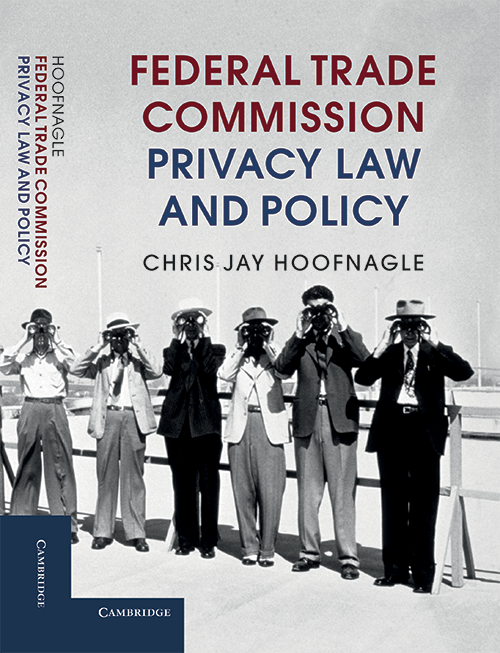Federal Trade Commission Privacy Law and Policy (FTCPL&P) is my 2016 book on the FTC. It is really two books. The first part details the agency’s consumer protection history from its founding, and in so doing, it sets the context for the FTC’s powers and how it is apt to apply them. The book has an institutional analysis discussing the internal dynamics that shape agency behavior. It details how the FTC policed advertising with treatments of substantiation, the Chicago School debates, the problem of advertising to children, and the Reagan revolution. The second part of the book explains the FTC’s approach to privacy in different contexts (online privacy, security, financial, children’s, marketing, and international). One thesis of the book is that the FTC has adapted its decades of advertising law cases to the problem of privacy. There are advantages and disadvantages to the advertising law approach, but do understand that if you are a privacy lawyer, you are really an advertising law lawyer 🙂
FTCPL&P has been reviewed in the Journal of Economic Literature, the ABA Antitrust Source, the European Data Protection Law Review, World Competition, and the International Journal of Constitutional Law. offers comprehensive consulting, management, design, and research solutions. Every architectural endeavor is an opportunity to shape the future

FTC Posts
-
Assessing the Federal Trade Commission’s Privacy Assessments
Why read this article? This short article points out the big differences between an “audit,” and an “assessment,” the latter of which is the tool used by the Federal Trade Commission to oversee companies that are subject to consent decrees. “Assessment” is a term of art in accounting wherein a client defines the basis for…
-
Comments on the CCPA
I filed the following comments today on the CCPA to the CA AG. March 8, 2019 VIA Email California Department of Justice ATTN: Privacy Regulations Coordinator 300 S. Spring St. Los Angeles, CA 90013 Re: Comments on Assembly Bill 375, the California Consumer Privacy Act of 2018 Dear Attorney General Becerra, I helped conceive of…
-
Amsterdam Privacy Conference 2018
Opening keynote talk on The Tethered Economy, 87(4) Geo. Wash. L. Rev. ___ (2019)(with Aaron Perzanowski and Aniket Kesari), Amsterdam Privacy Conference, Oct. 2018.
-
Syllabi
I’m getting a lot of requests for my syllabi. Here are links to my most recent courses. Please note that we changed our LMS in 2014 and so some of my older course syllabi are missing. I’m going to round those up. Cybersecurity in Context (Fall 2019, Fall 2018) Cybersecurity Reading Group (Spring 2020, Spring…
-
Embrace legitimate cost–benefit analysis, recognize that much of it is not legitimate
From Federal Trade Commission Privacy Law and Policy, Chapter 12: The FTC is surrounded by critics who urge that Agency actions must be more “rigorous” or based in the “sound economic policy” of cost–benefit analysis. There is some merit to this argument. As Peter Schuck explains, cost–benefit analysis has much to offer policy-makers.39 Consumer advocates…
-
Bait-and-switch advertising, bait-and-switch privacy
From Federal Trade Commission Privacy Law and Policy, Chapter 12: Professor Ross Petty highlighted that some of Posner’s objections reflected unstated assumptions and that recognizing these help us see the deficits of the Posner critique.27 For instance, Posner dismissed the Agency’s bait-and-switch advertising work without explaining his underlying objection to policing such marketing techniques. For…
-
Reinvigorating Consumer Protection
Professor Mark Nadel suggests four core challenges to making consumer protection a widespread concern: First, consumer interests are diffuse; it is a collective value and must compete with other values. Second, individuals have varying levels of intensity of interest in consumer matters. Mostly, this is a low- level interest, and it can be satisfied with…
-
Should Regulation Be “Technology Neutral”?
Both consumer and industry advocates argue that regulation should be “technology-neutral.” Bert-Jaap Koops has carefully explored the demand for technology-neutral regulation. He begins the inquiry by asking why technology law in particular should be technology-neutral. Koops uses the example of traffic law, where there are no calls for uniform technical rules for bicycles, cars, and…
-
Is Technology “Neutral”?
A kind of paradox is presented by modern technophiles. In the same breath they declare that technology is neutral while touting technology as the actuator of pro-democratic political change.37 In the academic community, many have argued that technology is not neutral but rather a profound “part of our very humanity.”38 In The Whale and the…
-
Chairman Pertschuk’s lessons on regulation
Chairman Michael Pertschuk was one of the most qualified FTC leaders ever. Educated at Yale Law School, he clerked for a federal district judge, practiced at a firm, and then spent fifteen years on Capitol Hill. His Hill experience brought him great expertise in consumer protection, as he was chief counsel to the Senate Commerce…
-
On this day in 2000, The NAI Promised Not to Merge Offline Data with Online Data
DoubleClick was among the founding NAI Members.
-
DOC: No Records on Privacy Shield Removal Procedure
Back in November, I posted the Department of Commerce’s Privacy Shield checklist. The next logical step was to request DOC’s procedures for removal of companies from the Privacy Shield (submitted Dec. 1). Today, DOC-International Trade Administration responded with a “no records” response. It is not clear to me what date the search took place, and…